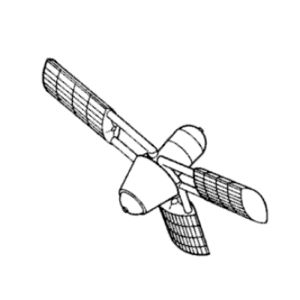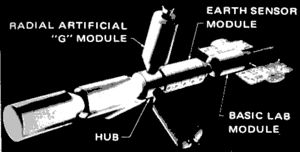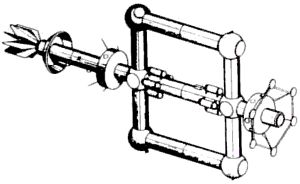
Home - Search - Browse - Alphabetic Index: 0- 1- 2- 3- 4- 5- 6- 7- 8- 9
A- B- C- D- E- F- G- H- I- J- K- L- M- N- O- P- Q- R- S- T- U- V- W- X- Y- Z
Self-Deploying Space Station
 Rigid Station 2 Credit: NASA |
Status: Study 1963.
This resulted in a number of interesting single-launch designs with unfolding station structures. By the mid-1960's these had been abandoned at NASA in favor of zero-G monolithic stations.
The Self-Deploying Space Station began with a design study in June 1960 by North American Aviation under NASA contract NAS1-1630. The concept was for a rotating space station providing 0.2 G of artificial gravity, that could be orbited in a single launch of a two-stage Saturn C-5 and unfold in orbit without any assembly required. This meant it had to packaged into a 10 m diameter with a mass of no more than 77,200 kg, including an Apollo spacecraft that would be put into orbit together with the station.
The baseline design was hexagonal, with six 23 m long x 3 m diameter modules forming the rim, connected to the hub by 1.5 m diameter, 14.6 m long spokes. Each rim module had a single open volume with an 81 cm wide aisle. Each module was autonomous, with its own environmental control system, supplies for two days of operations in an emergency, and a control center. Electrical power was provided by two solar arrays that deployed from the sides of each module. The station was kept oriented toward the sun at all times. Cabin atmosphere was 0.27 bar oxygen and 0.41 bar nitrogen, with sufficient supply carried for two complete repressurisations. The ECS scrubbed carbon dioxide, dust, water vapor, and contaminants from the air but was not closed-cycle. The floor made a continuous curve, so that although the external surface of the rim was hexagonal, the floor surfaces within the station were circular to minimize variations in artificial G. Work areas were recessed in the floor.
Crew was set at 21, resulting in 7 men being continuously on duty in three eight-hour shifts. Three of the modules provided living quarters, allowing each shift to rest undisturbed in their own bunks. One end of the living module had the hygiene center, with a shower, two sinks, a laundry, and dressing area. At the other end was a control center, with the sleeping area in between. It was felt necessary for one member of each shift to monitor the control center while the other six slept.
The other three rim components were work modules, to which the spokes connected. One working module had a sickbay and dispensary, complete with an operating table. The others contained instruments and laboratories of various kinds.
The hub was 3.9 m in diameter and 5.2 m long. At launch it was topped by a single Apollo spacecraft. Following deployment of the spokes and hub in orbit, the Apollo would separate from the station, move away, transpose, and redock with the hub. The top of the hub was equipped with a single axial port and six radial docking ports for Apollo spacecraft. This section would be despun during docking operations. The lower part of the hub was dedicated to a zero-G laboratory. Spacecraft would have to be docked to the radial ports in pairs to maintain balance. If an odd number of spacecraft were at the station, the odd one out would have to dock at the top port in order to maintain balance.
Alternative station configurations included purely circular rims, using inflatable elements, as in von Braun's original design of the 1950's; and a design consisting of three elliptical radial arms. In the latter design each arm had three decks, each deck 2.4 m high and 4.5 m in diameter internally. Externally each arm was 14.7 m in diameter and 18.6 m long. A central tube provided access between decks. In this concept the G force would vary by deck, so the crew's sleep quarters were in the maximum 0.2 G floor at the outer edge of the spoke, followed by two work areas in each case. The radial design was very popular with artists in the 1960's and formed the basis of the Revell "Pilgrim One" model kit.
North American built a 10% scale model of the station to test deployment mechanics, weighing 320 kg. Tests showed the optimum deployment time was 2 minutes, which scaled to 30 minutes for a full-size station. The station used the 'Busemann Hinge', developed by Adolph Busemann of NASA's Langley Research Center. Tests of various designs continued through 1963, one of the most popular being the radial spoke station using elliptical cross-section spokes. The radial design was very popular with artists in the 1960's and formed the basis of the Revell "Pilgrim One" model kit.
Family: Space station, Space station orbit, USA - Space Stations. Country: USA. Launch Vehicles: Saturn V. Agency: NASA.
 | Radial Station Credit: NASA |
 | LORL Space Station Large Orbital Research Station with docked Dynasoar ferry Credit: US Air Force |
 | Apollo Station Credit: NASA |
 | 4 Module Station Credit: NASA |
 | Rigid Station 1 Credit: NASA |
Back to top of page
Home - Search - Browse - Alphabetic Index: 0- 1- 2- 3- 4- 5- 6- 7- 8- 9
A- B- C- D- E- F- G- H- I- J- K- L- M- N- O- P- Q- R- S- T- U- V- W- X- Y- Z
© 1997-2019 Mark Wade - Contact
© / Conditions for Use